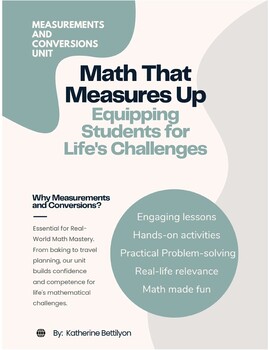Math That Measures Up: Measurements and Conversions
Katherine Bettilyon
4 Followers
Grade Levels
4th - 8th, Homeschool
Subjects
Resource Type
Standards
CCSS4.MD.A.1
CCSS4.MD.A.2
CCSS5.MD.A.1
CCSS5.MD.C.3
CCSS5.MD.C.3a
Formats Included
- PDF
Pages
47 pages
Katherine Bettilyon
4 Followers
Description
Teachers and Homeschool Parents! Dive into math with our ‘Math That Measures Up: Measurements and Conversions’ unit! Designed for upper elementary and Middle school (10–14-year-olds). This 5-week program seamlessly integrates essential math concepts with real-world applications. From mastering measurement basics to confidently tackling unit conversions, students embark on an engaging journey filled with hands-on activities, interactive lessons, and practical challenges. Ideal for teachers and homeschooling families, this unit empowers learners to develop critical math skills essential for everyday life.
Total Pages
47 pages
Answer Key
Included
Teaching Duration
1 month
Last updated 1 month ago
Report this resource to TPT
Reported resources will be reviewed by our team. Report this resource to let us know if this resource violates TPT’s content guidelines.
Standards
to see state-specific standards (only available in the US).
CCSS4.MD.A.1
Know relative sizes of measurement units within one system of units including km, m, cm; kg, g; lb, oz.; l, ml; hr, min, sec. Within a single system of measurement, express measurements in a larger unit in terms of a smaller unit. Record measurement equivalents in a two-column table. For example, know that 1 ft is 12 times as long as 1 in. Express the length of a 4 ft snake as 48 in. Generate a conversion table for feet and inches listing the number pairs (1, 12), (2, 24), (3, 36),...
CCSS4.MD.A.2
Use the four operations to solve word problems involving distances, intervals of time, liquid volumes, masses of objects, and money, including problems involving simple fractions or decimals, and problems that require expressing measurements given in a larger unit in terms of a smaller unit. Represent measurement quantities using diagrams such as number line diagrams that feature a measurement scale.
CCSS5.MD.A.1
Convert among different-sized standard measurement units within a given measurement system (e.g., convert 5 cm to 0.05 m), and use these conversions in solving multi-step, real world problems.
CCSS5.MD.C.3
Recognize volume as an attribute of solid figures and understand concepts of volume measurement.
CCSS5.MD.C.3a
A cube with side length 1 unit, called a “unit cube,” is said to have “one cubic unit” of volume, and can be used to measure volume.





